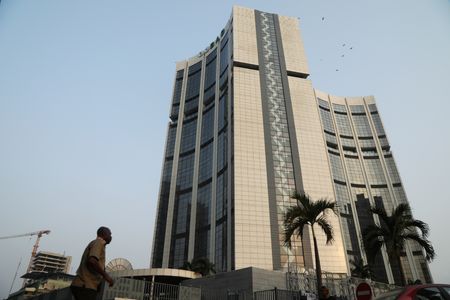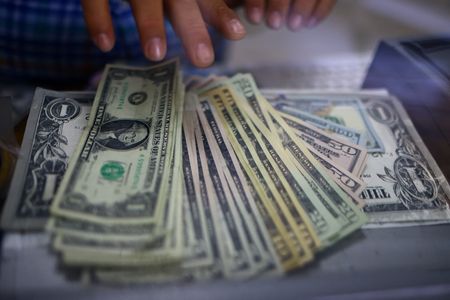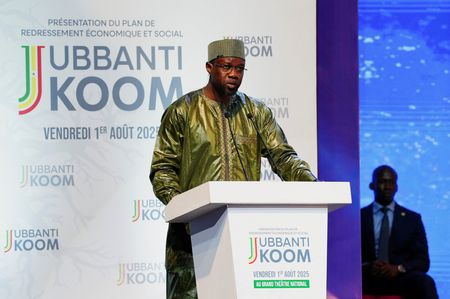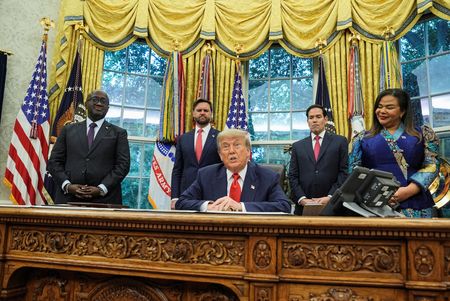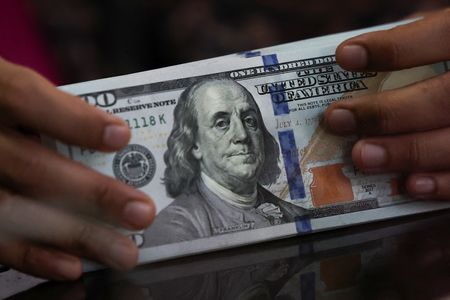By Duncan Miriri
NAIROBI (Reuters) – African leaders’ push to mobilise domestic sources of cash to help fund billions in sovereign borrowing will face slow progress until low savings rates rise and African investors step up, experts and analysts say.
The drive to tap their own bourses, pensions and savings funds comes after punishing years when spiralling costs locked many African countries out of international debt markets and a soaring U.S. dollar drove up their debt-servicing costs.
Borrowing at home, advocates say, would reduce reliance on volatile international markets, lower exposure to foreign currencies, and let African investors more familiar with local risks play a bigger role.
Samuel Maimbo, a development finance expert running to head the African Development Bank (AfDB) – the continent’s largest development finance institution – said leaders must fix Africa’s “entire plumbing of financing” to unlock more cash.
“I want to look at domestic sources of financing,” he said.
A growing number of people agree with Maimbo on how to move the 54-nation continent on from a spate of sovereign debt defaults and ongoing cash-crunch worries.
Africa’s financing concerns are also a topic at the G20 finance ministers and central bankers meeting underway in Cape Town amid heightened investor uncertainty following Donald Trump’s return to the White House.
“Many countries on the African continent are almost facing debt distress,” Lesetja Kganyago, governor of the South African Reserve Bank told Reuters on the sidelines of the meeting in Cape Town.
“All the countries on the African continent are small, open economies, and small, open economies depend on global trade.”
Africa’s financing needs are huge. The AfDB puts the annual financing gap for structural transformation at more than $400 billion – or nearly 14% of the continent’s projected GDP by 2030.
Adding to the urgency are rising debt repayments due from 2026, with analysts saying an overall structural weakening of riskier African economies is raising the spectre of more debt strains ahead.
Debt levels are high: External public debt surpassed $1 trillion in 2023, from less than half that in 2010, UNCTAD figures showed. Debt-servicing costs stood at $163 billion in 2024, having nearly trebled since 2010, according to AfDB calculations.
AFRICA PREMIUM?
Africa is reeling from the nearly two years up to 2024 when the global interest rate-hiking cycle priced it out of the market and helped push Ghana and Zambia into default.
Only two countries – Botswana and Mauritius – have investment-grade credit ratings. Lower ratings elsewhere add to high borrowing costs, a phenomenon some leaders call an “Africa premium.”
“A shared experience is disproportionately high costs of securing credit compared with other regions of the world,” said Rugare Mukanganga, economic adviser at Development Reimagined.
Africa’s public debt in local-currency domestic bonds was just over $800 billion in 2020, according to the International Capital Market Association, with 40% of that in South Africa alone. It pales compared with the roughly $6 trillion in Asia Pacific excluding China and Japan.
Banji Fehintola, executive director of the Africa Finance Corporation (AFC), said the continent’s central banks hold $450 billion in hard currency reserves while sovereign wealth funds, pension funds and insurance firms have another $600 billion.
“Why can’t that capital fund Africa’s development?” he said. “Africa actually has options and those options are available domestically even in hard currency.”
In September, the AFC helped the Nigerian government raise $900 million through its first-ever domestic dollar bond.
NO PANACEA
But raising billions domestically won’t be easy.
“This is not a magic solution,” said Charlie Robertson, head of macro strategy at FIM Partners. “The structural challenge is a shortage of local savings.”
Sub-Saharan Africa has a savings rate of 18%, World Bank data shows – less than half the 36% global average, due partly to its youthful population having limited disposable income.
The IMF has warned that low liquidity hinders cash mobilisation. The market capitalisation of securities exchanges in sub-Saharan Africa, excluding South Africa, averaged less than 20% of GDP, compared with 50% in other developing economies and 126% in advanced ones.
“Markets remain shallow and underdeveloped,” an IMF spokesperson said.
Borrowing at home can also put people’s own money at risk.
Ghana restructured local debt, damaging the savings of the nascent middle class and feeding anger that led to the ruling party’s defeat in last year’s presidential election.
Increased local government borrowing can also create competition with private borrowers, driving up interest rates.
Kenyan Finance Minister John Mbadi said the country – which has struggled to contain high commercial interest rates – was “overborrowing domestically”.
WORKING TO THE SOLUTION
But leaders, including current AfDB President Akinwumi Adesina, say there are solutions.
Ethiopia, which defaulted on international bonds in 2023, opened Africa’s newest capital market last month, part of far-reaching, IMF-backed economic reforms.
Kenya’s regulator also licensed last year the East Africa Bonds Exchange, which will compete with the Nairobi Securities Exchange where annual bond-trading turnover averages 700 billion shillings ($5.4 billion).
The Nairobi bourse is part of an AfDB-backed push by 10 African exchanges to deepen local debt markets.
“If you look at the interest rate, they are actually paying for access to (international) capital markets. That tells me there is an issue for Africa,” said AfDB’s Adesina.
($1 = 129.1500 Kenyan shillings)
(Reporting by Duncan Miriri; Editing by Libby George and Hugh Lawson)

